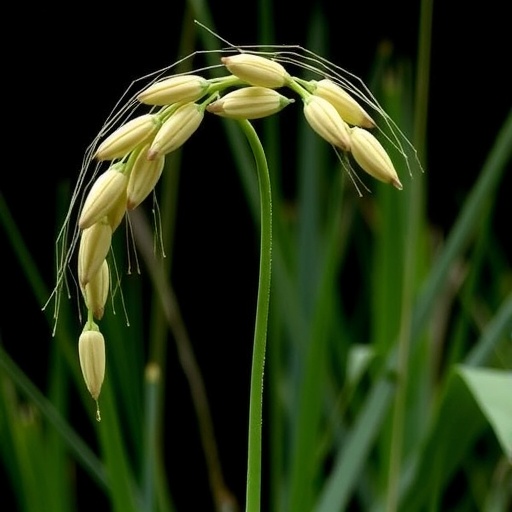In the intricate world of plant genetics, a groundbreaking study has shed new light on the complex chromosomal structures influencing the flowering time of hexaploid oat, one of the world’s most important cereal crops. Recent advances by Avni et al. in their comprehensive pangenome and pantranscriptome analysis have unraveled a chromosomal inversion on chromosome 7D that bears significant implications for oat breeding and adaptation, potentially unlocking faster-flowering oat varieties that are more robust under changing climatic conditions.
At the heart of this discovery lies a curious phenomenon first hinted at by Tinker and colleagues, who observed a complete absence of recombination in a genomic region across chromosome 7D. This puzzling lack of genetic reshuffling suggested the existence of an inversion—a large segment of DNA flipped in orientation—disrupting normal meiotic exchanges. With the power of new high-throughput sequencing technologies and expansive sample sizes, Avni’s team confirmed this elusive inversion, marked predominantly by stark haplotype divergence in pericentromeric regions long thought to be genetically inert.
By examining over 295 diverse oat varieties predominantly sourced from North America’s Collaborative Oat Research Enterprise (CORE) panel, researchers identified two distinct haplotypes on chromosome 7D, clearly demarcating the ancestral and derived forms of the inversion. The less frequent haplotype corresponded to the ancestral genetic state, as corroborated by its presence in Avena insularis, a closely related species harboring the original allelic arrangement. Conversely, the widespread haplotype indicated a recent chromosomal rearrangement—one intimately linked to shifts in key phenotypic traits.
Among its many impacts, the inversion stands out for its direct connection to flowering time, a vital trait that governs the adaptability and yield potential of oats. The team employed genome-wide association scans leveraging kmerGWAS methodology, unveiling significant loci on chromosomes 7A and 7D associated with heading date variation. Crucially, carriers of the ancestral haplotype on 7D flowered almost four days earlier on average than those sporting the derived inversion, a difference substantial enough to influence growing season length and crop performance across different environments.
Delving deeper into the molecular mechanisms, the study pinpointed crucial flowering time regulators within the inversion boundaries, including a paralogous pair of FT1/VRN3 homologues—genes well known for their central roles in the floral transition of cereals. Notably, the FT1 gene on chromosome 7D exhibited markedly higher expression levels in the inverted genotype, especially in internode tissues, correlating with the altered phenology observed in the field. This enhanced expression may reshape flowering regulatory networks, thus affecting plant development trajectories substantially.
The investigation did not stop at expression profiling. Researchers unearthed subtle yet functionally important structural variations within these flowering regulators, including an 18-base pair deletion exclusive to inverted alleles in FT1 on chromosome 7D. Interestingly, its 7A paralogue carried a 12-base pair deletion predicted to create a premature stop codon, effectively truncating the associated protein product. Such mutations underscore complex evolutionary pressures and potential trade-offs embedded within these chromosome rearrangements.
This inversion’s genomic architecture likely suppresses recombination across a wide region, maintaining linkage disequilibrium between multiple flowering time genes and associated variants. It poses a key question: Does the inversion cause early flowering directly through specific gene regulation changes, or is it the collective consequence of restricted recombination preserving co-adapted gene complexes? Both paths offer fascinating insights into how plants can rapidly evolve new phenotypes via chromosomal rearrangements.
Moreover, the inversion’s prevalence raises intriguing evolutionary and breeding considerations. On one hand, it represents a genomic signature of adaptation—favoring particular growth cycles responsive to regional environments. On the other, the suppression of recombination can hinder genetic diversity and complicate classical breeding approaches, necessitating newer genomics-informed strategies to harness its benefits without unintended genetic bottlenecks.
The team’s work exemplifies the power of integrated pangenomic approaches that capture species-wide genetic diversity beyond a reference genome framework. By combining deep resequencing with transcriptional profiling and structural variant analyses, this study unravels hidden layers of complexity that shape agronomically critical traits. It paves the way for precision editing or marker-assisted selection targeted at these structural variants to fine-tune flowering time in oats.
Future research is poised to dissect the broader physiological and ecological consequences of this inversion, including its interaction with photoperiod sensitivity genes and environmental cues. Understanding whether altered gene proximity caused by the inversion repositioning alters regulatory element accessibility or chromatin conformation will be central to decoding its mechanistic underpinnings.
In sum, the discovery of a large-scale inversion on chromosome 7D, influencing flowering time regulators like FT1/VRN3, offers a novel genomic landmark for oat improvement. It connects cytogenetic insights with modern genome-wide analyses, marking a step-change in our understanding of the genetic architecture underlying key adaptation traits in a staple crop. As the global climate continues to shift, such fundamental knowledge will be indispensable in breeding oats that thrive across diverse agroecosystems, securing food supply and agricultural sustainability.
Subject of Research: Genetic rearrangements and flowering time regulation in hexaploid oat.
Article Title: A pangenome and pantranscriptome of hexaploid oat.
Article References:
Avni, R., Kamal, N., Bitz, L. et al. A pangenome and pantranscriptome of hexaploid oat. Nature (2025). https://doi.org/10.1038/s41586-025-09676-7
Image Credits: AI Generated




